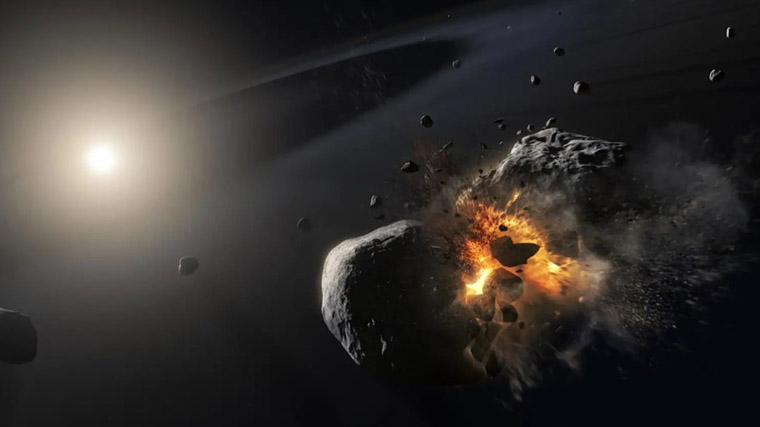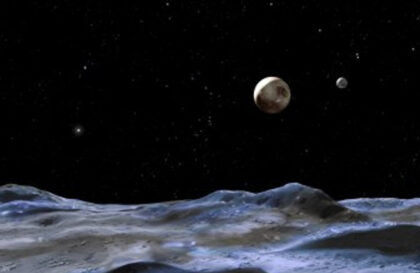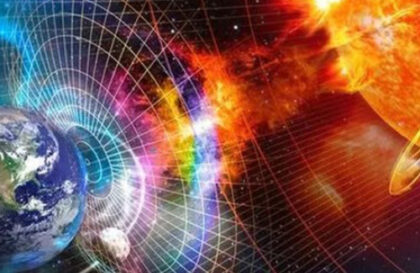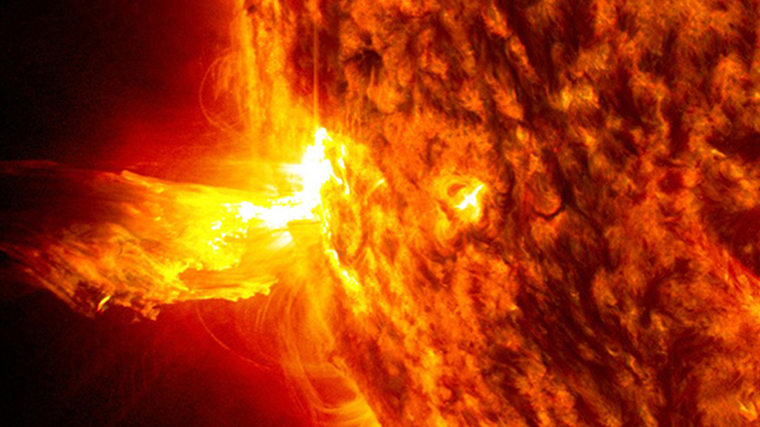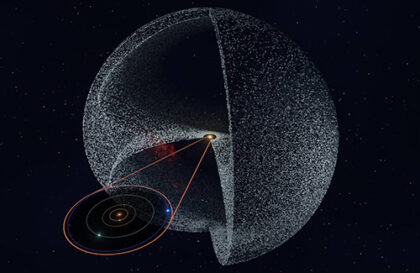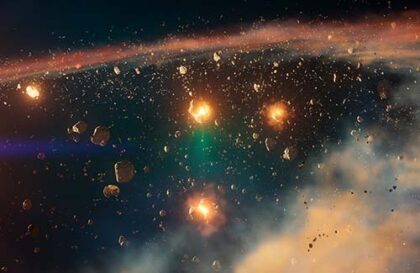How it all began?
An endless cloud of hydrogen and helium molecules is ready to form stars and planets. Its gravity causes it to collapse, but temperature and pressure prevent it from doing so. There is a fight going on. But there is a small perturbation: the density of one region (part of the cloud) becomes slightly larger than that of others. The cloud becomes inhomogeneous and, as it cools, breaks up into clumps that will collapse further to become stars.
This is how a star similar to our Sun appeared – and hundreds more stars over 250 million years. Since then, they’ve all been mixed like raisins in dough.
The first stars immediately set about making the first batch of heavier elements like oxygen, silicon, and magnesium, which are essential for Earth-like planets.
About 5 billion years ago, another star collided with the Sun, resulting in a cigar-shaped plume of gases from which planets fell out like beads – large yellowish in the middle and tiny brown-purple at the edges.
And this is one of the versions of the origin of the planets.
Today, we believe that the formation of planets around solar-type stars is completed for several million years to several hundred million years.
Our planet Earth began as a swarm of icy and rocky bodies that orbited the Sun and gradually grew into planets. The initially formed planets collided with each other, connecting into larger bodies and their satellites. These were heavyweight fights. All sorts of debris broke off from their blows, mixed with the remnants of the original swarm, now these are comets and asteroids.
After 100 million years, the turmoil subsided. However, the collisions continued until the planets began to move along non-intersecting paths. All the major impacts that were supposed to happen happened, and the system became stable like a clockwork. Well, almost.
Almost every planet and almost every satellite of a planet that has ever existed in the solar system has been consumed by a body larger than itself, and this fact is incredibly important.
Most of the planets are now inside the gas giants Jupiter and Saturn or the Sun, and some are inside Uranus or Neptune. It is believed that there were two or three more giants, roughly equal in mass to Neptune, but they were absorbed by the Sun or thrown out of the system to wander the Galaxy.
Why are the planets different?
If the planets came from clouds of primordial matter, why weren’t they more or less the same, like raindrops condensed out of a cloud?
Jupiter and Saturn are similar – they are two spheres composed mainly of hydrogen (H) and helium (He). Neptune and Uranus seem to be even more similar – giant spheres made up mostly of H2O, H, and He.
The rest of the bodies (not just the planets) in the solar system are as diverse as the states of Europe.
Water?
One of the most common chemical compounds in the universe is water H2O. It exists mainly in the form of steam. At distances of 2-3 a.u. from the Sun, it crystallized and condensed into frost, which probably formed the embryos of comets. Today they are concentrated in the Oort cloud. And earlier this ice participated in the formation of ice giants.
Closer to the Sun, silicates condensed to form planetesimal rocks, the ancestors of rocky planets such as Earth or Mars.
The line separating the rocky planets from the planets of the giants is called the Ice Line. This “frost line” idea gained popularity as a basis for understanding why Earth-like rocky planets are closer to the Sun, and gas and ice giants, as well as ice dwarfs, are farther away.
The friction of rocks on ice from tidal forces and radioactive decay generates heat, allowing water to exist in liquid form. The moons Europa and Enceladus, Ganymede, and Titan have liquid oceans of water.
Structured protoplanetary disk?
Ramon Brasser, a researcher at the Tokyo Institute of Technology, and Steven Moijsis, a scientist at the University of Colorado at Boulder, conducted a study on “The Separation of the Inner and Outer Solar System by a Structured Protoplanetary Disk.”
In their work, they sought to elucidate the phenomenon of the location of terrestrial planets (Mercury, Venus, Earth, Mars) in the inner part of the solar system with a rocky structure, in contrast to gas giants (Jupiter and Saturn) and ice giants (Uranus and Neptune).
The authors used computer models to study the role of Jupiter in shaping the structure of the solar system. As a result, they concluded that the “great separation” was due to a protoplanetary disk that formed around a young star and had zones of high and low pressure of gas and dust.
This process, according to their hypothesis, contributed to the formation of various types of planets in the solar system. The experts backed up their conclusions with data from the ALMA telescope, which found similar structures in young star systems.
They also believe that the protoplanetary disk consisted of several rings, which contributed to the separation of gas giants and terrestrial planets at different distances from the Sun.
Other options:
Nebular hypothesis
According to the nebular hypothesis, the Sun was formed from molecular clouds, and the material around it, subjected to gravitational influence, formed planets, satellites, asteroids, and comets. However, such models cannot explain the origin of gas giants. It would take many millions of years for planets to form from dense matter around a young Sun. By that time, the light gases that makeup Jupiter and Saturn had already disappeared.
According to researcher Kevin J. Walsh, Southwestern Research Institute, perhaps due to the instability of the protoplanetary disk, dense clouds of dust and gas began to interact with each other even at the stage of the formation of the Sun. This contributed to the faster formation of gas giants than through mutual collisions under the influence of the Sun’s gravity.
Walsh suggests that the gas giants could have formed in as little as a thousand years while holding on to lighter gases. They also quickly gained mass, which determined their farthest orbits from the Sun.
Model of Nice
The problem of the distance between the gas giants has also been considered. The Nice model implies that the gas giants were closer together in the early solar system, but due to the activity of rocks and ice in the scattered protoplanetary disk, the distance between them increased. The terrestrial planets moved closer to the Sun, while the gas giants moved away.
US scientists Michael Brown and Konstantin Batygin suggested that there could be another planet in the solar system beyond the orbit of Neptune. They suggest that this object is Planet Nine or Planet X, which may be a gas giant with a core of metals and silicates, covered with ice. It affects objects in the Kuiper belt. Confirmation of the hypothesis is found in the bending of light from distant objects and their gravitational influence.
Image credit:
ttps://scitechdaily.com
https://www.icds.psu.edu
